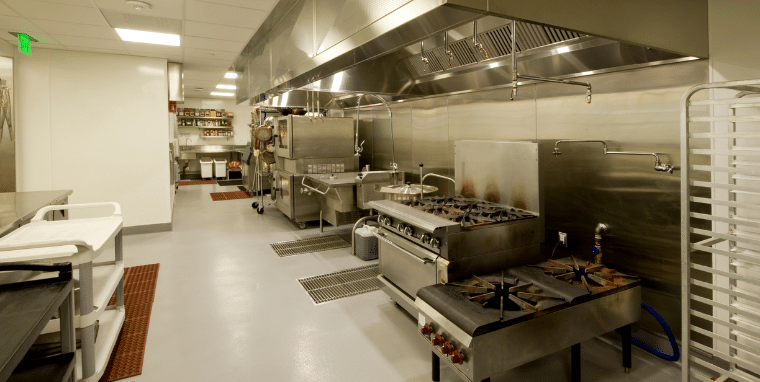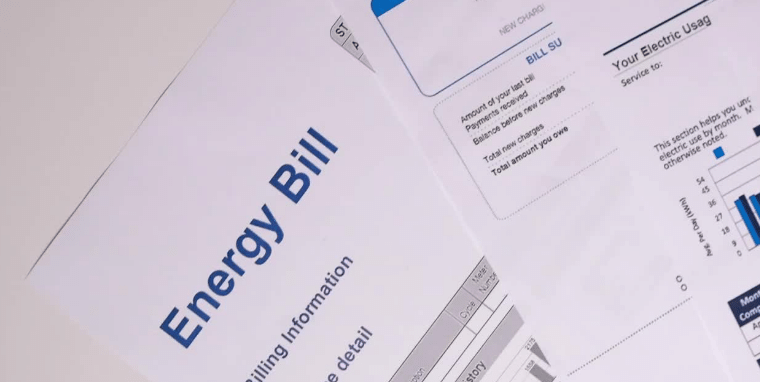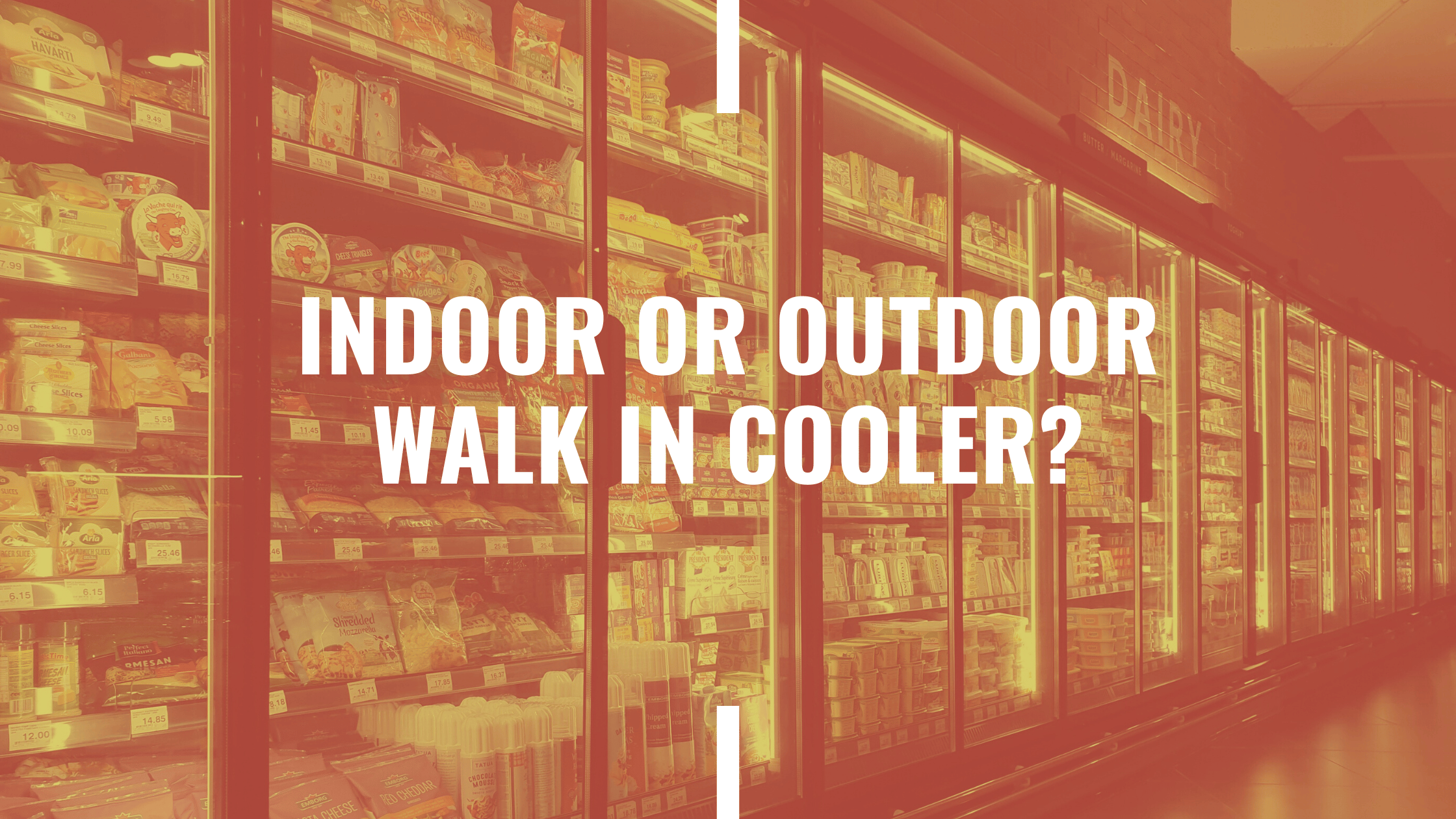Is an Outdoor Walk in Cooler Right for You?
Now that you have a better understanding of what a walk in cooler is and how one is made, let's discuss which type of cooler is right for you - an indoor walk in cooler or an outdoor walk in cooler?
Free Download: The Ultimate Guide to Buying a Walk-in Cooler in 2023
Both offer pros and cons. The right one for you depends on these factors:
Space Availability
One of the first questions someone shopping for a walk in cooler has is:
"How big does my walk in cooler need to be?"
A general rule of thumb for restaurants is to calculate 1 to 1.5 cubic feet of walk in cooler storage for every meal you intend to serve daily.
Another general rule of thumb is to calculate 1 cubic foot of cold storage space for every 28 to 30 pounds of perishables stored. Take that number and multiply it by a factor of 2.5 to compensate for aisle space and space between different types of perishables.
These general rules give you an idea of how big your box and refrigeration unit need to be. An experienced restaurant equipment dealer, licensed commercial refrigeration contractor, or manufacturer's sales rep can help you decide on the right size.

Once you know how big your walk in cooler needs to be, your next question is:
"Do I have enough space for an indoor walk in cooler?"
When considering an indoor walk in cooler, keep in mind you must leave 3 to 5 inches of space on all sides of your cooler to allow for proper ventilation and at least 6 inches between the refrigeration unit and the ceiling if you're considering an indoor condensing unit.
We know how valuable every square inch of space is for restaurants, breweries, flower shops, ice creameries, bakeries, etc. On average, a walk in cooler is going to take up anywhere from 36 to 144 square feet of space, so ask yourself:
"Is a walk in cooler the highest and best use for this space?"
If the answer is no, an outdoor walk in cooler may be right for you.
But wait. Don't request a quote for an outdoor walk in cooler just yet. You still have three other factors to consider.
Accessibility
Having easy and direct access to your perishables is one of the main advantages of an indoor walk in cooler, and a big reason why approximately 90% of all walk in coolers are located indoors.

Think about your workflow and ask yourself:
"How many times will I (we) walk to and from the walk in cooler every day?"
The answer to this question varies. Knowing your answer is important.
Outdoor walk in coolers can be "butted" up against a building wall with a door accessible from inside or they can be separate freestanding structures with no access from inside.
If you're considering a freestanding outdoor walk in cooler (i.e., the path of least resistance), think about what it means to go outside every time you visit your cooler.
How does this affect your workflow?
How about weather? Is it cold? Is it snowing? Is it raining? Is it Florida humid?
Now switch hats for a minute and think about your process for receiving deliveries. Generally-speaking, an outdoor walk in cooler makes storing delivered perishables much easier.
Are quick and painless deliveries enough to overcome the easy access afforded by an indoor walk in cooler?
Only you know the answer to this.
Upfront Costs
All things equal, an outdoor walk in cooler costs more than an indoor cooler.
This is because an outdoor cooler requires a rain roof cover, door hood (aka drip cap), and refrigeration hood to protect your box and refrigeration unit from the elements.
Building a walk in cooler outdoors is also more expensive simply because it involves more labor..png?width=760&name=outdoor%20walk%20in%20cooler%204%20(1).png)
Additional upfront costs for an outdoor walk in cooler can include:
- A Concrete Pad - Certain governmental authorities require outdoor walk in coolers to be built on top of a concrete pad. A concrete pad may also be necessary if your floor is not level. Discuss this with your restaurant equipment dealer or commercial refrigeration contractor.
- Construction - An outdoor cooler "butted" up against your building makes your cooler more accessible, but this requires constructing a door from your building into the cooler. This type of work generally involves architects, engineers, general contractors, and municipal inspectors aka people who charge fee$.
- Customizations - Sloped ceilings may be necessary for large outdoor walk-ins in areas with heavy snowfall and rainfall.
- Security Measures - Some business owners may consider additional security measures like a locking bar, alarm, or perimeter fence.
- Space Heaters - You might need to invest in a space heater to keep your outdoor cooler at the right temperature range if you experience sub-freezing temperatures in your area.
- Larger Refrigeration Unit - Conversely, you might need to invest in a larger refrigeration unit to keep your outdoor cooler at the right temperature range if you experience extreme heat or humidity in your area.
Ongoing Costs
Unlike an outdoor cooler, building a walk in cooler indoors provides you the option of installing a self-contained refrigeration unit indoors or an evaporator coil inside with a remote condensing unit outdoors.
Indoor or Self-Contained Refrigeration Units
A self-contained refrigeration unit is an all-in-one refrigeration system that houses all of its components, such as the evaporator and condensing unit, together.
Installing a self-contained unit indoors is typically the less expensive option upfront, but it's important to consider some of the ongoing costs associated with doing so.
Think about how the noise and heat from a condensing unit can affect your employee and customer experience.
This seemingly unimportant detail is often overlooked by business owners. Don't make this mistake. An uncomfortable environment could end up costing you real money.
A self-contained refrigeration unit can also lead to higher energy bills.
If you're considering installing your cooler and condensing unit inside a kitchen in close proximity to other appliances, think about how much heat and grease your grills, fryers, ovens, and vents emit.
Now consider the hot air your condensing unit will add to the environment. The heat from your kitchen appliances and condensing unit will undoubtedly force your refrigeration and HVAC units to work harder.
The harder your refrigeration and HVAC units work, the more energy they consume. The more energy they consume, the higher your ongoing operating costs.
Outdoor or Remote Refrigeration Units
The upfront cost of building an indoor walk in cooler with the evaporator coil inside and a remote condensing unit outside is higher than if you were to install everything indoors.
However, this combination maximizes your cooler's accessibility, reduces noise inside your establishment, and improves energy efficiency for most, but not necessarily all, businesses.

You may need a larger remote unit in hot and humid places like Florida, Louisiana, and Mississippi, or a space heater in regions with sub-freezing temperatures i.e., parts of the Northeast, Midwest, and Pacific Northwest.
Both consume more energy, which can lead to higher ongoing operating costs.
Wear & Tear
GALVALUME®, ACRYLUME®, and galvanized steel, the metal skins most commonly used by walk in cooler manufacturers, are highly resistant to corrosion.
However, the chances of your panels getting dinged-up increase considerably when your walk in cooler is outside. Once metals and alloys get scratched and dented, corrosion finds its way in.
Same thing with panel insulation, door gaskets, latches, and hinges. Expect them to wear and tear a lot sooner when they're exposed to the elements.
In Closing
Deciding whether an indoor or outdoor walk in cooler is right for you is a personal decision. What works for you might not work for another business and vice versa.
Asking yourself the right questions and answering them honestly is a great first step in the right direction.
Still not sure if an indoor or outdoor walk in cooler is right for you?
Talk to a Mr. Winter sales rep today. We've been helping small businesses like restaurants, convenience stores, breweries, bakeries, ice creameries, flower shops, and many others keep perishables fresh and profitable since 1976.
Now that you know which cooler - an indoor walk in cooler or an outdoor walk in cooler - works best, let's discuss what other options and accessories are available for you in the next chapter - Walk in Cooler Options and Accessories.


.png?width=760&height=292&name=Footer%20Image_How%20to%20Buy%20a%20Walk-in%20Cooler%20in%202023%20(1).png)